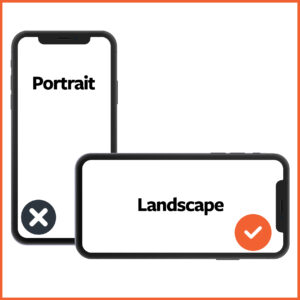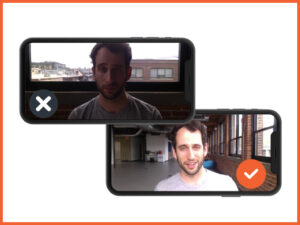
Best Practices for Filming with a Mobile Device
April 3, 2020
As more of the world works remotely, video allows us to remain seen and heard. But when the situation calls for recording video with a mobile phone, how can you ensure you look and sound your best? Check out these tips and best practices from APCO’s creative team.
Recording a video at 4K resolution is preferable, as this allows greater flexibility in the editing process. If your camera is not 4K compatible, record at the highest resolution possible (1080p). Keep in mind that 4K footage will require adequate storage space on your device. For example, 21 GB of storage is needed for one hour of 4K footage at 30 frames-per-second (fps). To capture video in 4K on your device, follow these steps:
Capturing clean audio is essential when filming on a mobile device. To maximize the audio quality:
 Position your device on a stable surface about 1–2 feet away from you and at eye level. If possible, use a low-cost smartphone tripod (available online). If a tripod is not an option, make sure the phone is leaning against an object that won’t move. Use books or other materials to ensure the device is at eye level.
Position your device on a stable surface about 1–2 feet away from you and at eye level. If possible, use a low-cost smartphone tripod (available online). If a tripod is not an option, make sure the phone is leaning against an object that won’t move. Use books or other materials to ensure the device is at eye level.
Orient the phone so that it is landscape mode, rather than portrait mode (see example). Use the front-facing camera to ensure you are fully centered within the image frame. When filming, remember to look into the front-facing camera lens. Avoid looking at your face, as this can change your eyeline and confuse viewers. Additionally, be mindful of any potentially distracting elements in the background of your image, and opt for a simple and neutral background.
To avoid dark, underexposed video, it’s important to make sure you are well-lit using light that is available.
 Make sure the main light source is in front of you—not behind you. Do not film with a window directly behind you; rather, use the window as a light source to illuminate your face. Avoid shadows on your face. Tap the screen on your face to auto-expose and auto- focus the image. If using an iPhone, tap and hold your finger down to lock in the exposure and focus. You should see the AE/AF Lock appear in yellow.
Make sure the main light source is in front of you—not behind you. Do not film with a window directly behind you; rather, use the window as a light source to illuminate your face. Avoid shadows on your face. Tap the screen on your face to auto-expose and auto- focus the image. If using an iPhone, tap and hold your finger down to lock in the exposure and focus. You should see the AE/AF Lock appear in yellow.
For further assistance with filming, or to inquire about our full video production and brand storytelling services, please contact Steve Salvador, creative director, Brand Programming: ssalvador@apcoworldwide.com. To view examples of our work, visit vimeo.com/channels/apcofeatures, and download a PDF of this guide here.
Click here for additional insights on working for home, from APCO’s global team.
This piece was coauthored by APCO Alum Patrick Foust.